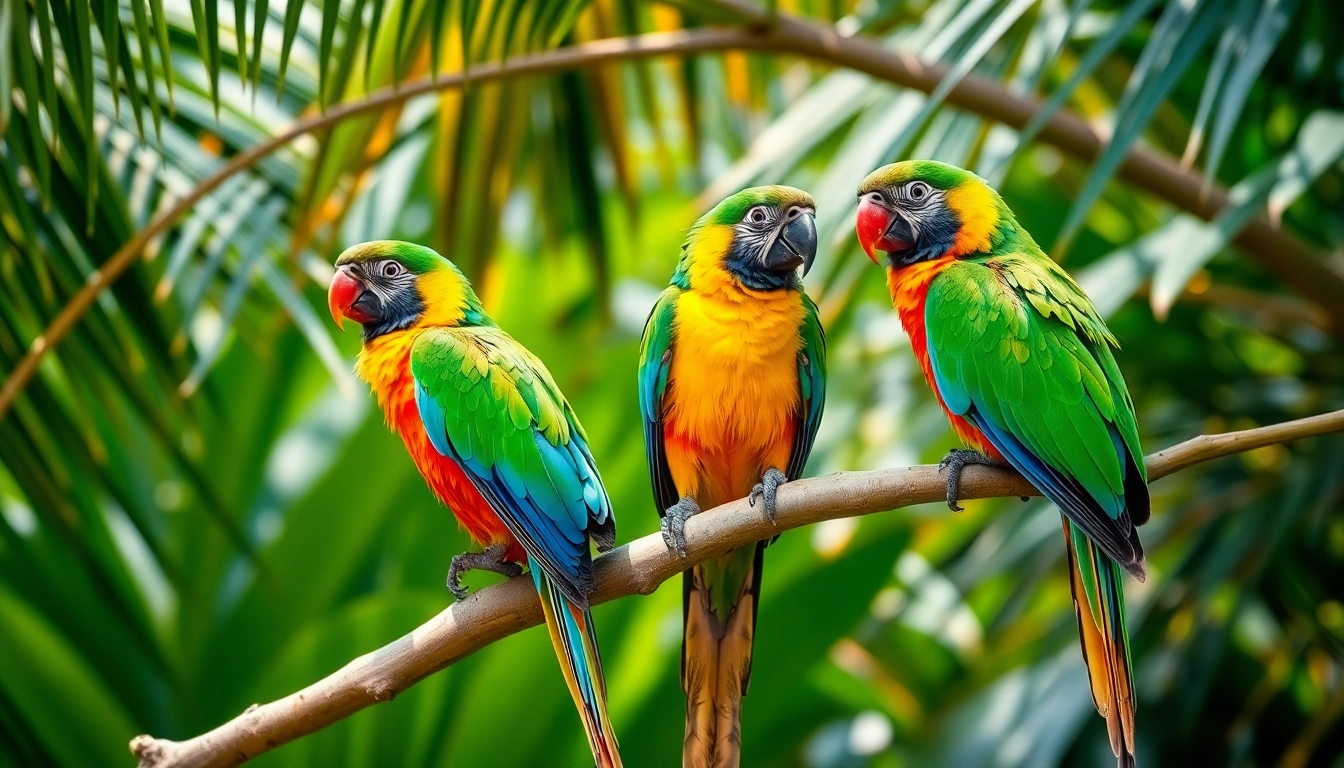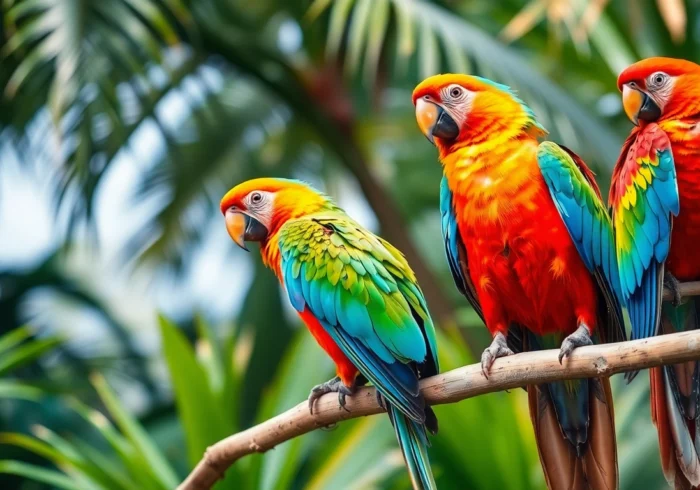Understanding Parrots: Basic Facts and Characteristics
Parrots, also known as psittacines, are one of the most fascinating and visually striking bird groups found across the globe. These vibrant, intelligent beings are renowned for their remarkable ability to mimic sounds and their complex behavioral patterns. Whether encountered in the wild or kept as beloved pets, parrots captivate animal enthusiasts, conservationists, and scientific researchers alike. To truly appreciate these extraordinary birds, it is essential to understand their defining features, diverse species, and behavioral traits.
parrots, with their strong curved beak, upright stance, and clawed feet, belong to the order Psittaciformes. They are predominantly tropical birds, inhabiting regions such as Central and South America, Africa, Australia, and parts of Asia. Their characteristic features not only serve functional purposes—such as feeding and climbing—but also contribute to their iconic appearance.
What Defines a Parrot: Features and Classifications
The primary physical characteristics that define a parrot include a strong, curved beak designed for cracking nuts, seeds, and other hard foods, as well as a zygodactyl foot arrangement—meaning two toes point forward and two backward—adapted for adept climbing and manipulating objects. Their upright stance and vibrant plumage serve as visual identifiers, with colors ranging from vivid reds and greens to striking blues and yellows. These visual cues are not just for aesthetics; they play vital roles in communication, mate selection, and camouflage.
Taxonomically, parrots are classified within the order Psittaciformes, which contains four families that encompass roughly 410 species across 101 genera. These species vary significantly in size, habitat preferences, and behavioral traits. The families include Psittacidae (true parrots), Cacatuidae (cockatoos), Strigopidae (New Zealand parrots, including Kakapo and Kea), and Halonpidae (bee parrots).
Key Species and Their Unique Traits
Among the vast diversity of parrots, several species stand out due to their distinctive characteristics and behaviors:
- Hyacinth Macaw: Known as the largest flying parrot, this species can reach up to 3.7 lbs and boasts stunning cobalt-blue feathers. Native to South America’s wetlands, they are highly social and intelligent.
- African Grey Parrots: Celebrated for their exceptional cognitive skills and ability to mimic human speech, these medium-sized birds are often kept as pets. They tend to form strong bonds with their owners.
- Kākāpō: A critically endangered flightless parrot endemic to New Zealand, notable for its nocturnal nature and robust build, with a lifespan that can reach 60 years.
- Amazon Parrots: Recognized for their vibrant green plumage and loud, raucous calls, Amazon parrots are popular as pets and display remarkable vocal mimicry abilities.
These species exemplify the incredible adaptations parrots have developed, such as specialized beaks for diet, advanced vocal communication, and social behaviors that facilitate survival in diverse environments.
Parrot Lifespans and Behavioral Patterns
The lifespan of parrots varies significantly among species, with some living well beyond two decades in captivity. For instance, Cockatoos can live between 40 to 60 years, while the Hyacinth Macaw often reaches around 50 years. Smaller parrot species like lovebirds may live around 10 to 15 years, emphasizing the importance of long-term commitment for prospective owners.
Parrots exhibit complex behavioral patterns driven by their intelligence and social nature. In the wild, they typically form large flocks for foraging and protection, displaying cooperative behaviors such as communal grooming and coordinated movement. Their social structure is vital for protection, mating, and resource sharing.
In captivity, these behavioral tendencies translate into a need for mental stimulation, social interaction, and environmental enrichment. Without proper engagement, parrots may develop destructive behaviors or suffer from psychological issues such as boredom or depression.
Popular Parrot Species and Their Habitats
Wild Parrots: Distribution and Natural Environments
Contrary to common perceptions, many parrot species thrive outside tropical rainforests, with some adapted to urban environments and dry regions. Wild parrots inhabit a range of ecosystems—from dense tropical forests of South America and Africa to open woodlands and coastal mangroves. For example, the Monk parakeet has adapted remarkably well to urban landscapes in the southern United States and parts of South America.
Their distribution is influenced by climate, availability of food resources, and nesting sites. In the wild, parrots primarily feed on seeds, nuts, fruits, and vegetation. Their ability to adapt varies among species; while some prefer isolated forests, others, like the Great Green Macaw, inhabit expansive riparian forests and mangroves.
Understanding their natural habitats is crucial for conservation efforts and for ensuring that pet owners replicate appropriate living conditions.
Common Pet Parrots: Care Requirements and Compatibility
Popular pet parrots include species like the Budgerigar, Cockatiel, African Grey, Amazon parrots, and Macaws. These birds often thrive with proper care, but each species has specific needs regarding cage size, diet, socialization, and environmental enrichment.
For example, larger parrots like Hyacinth Macaws require spacious cages and daily social interaction, whereas smaller species like lovebirds are more manageable but still demand mental stimulation and social companionship. Compatibility with owners depends on temperament, age, and training; some parrots are highly affectionate and form strong bonds, while others may prefer limited interaction.
To ensure a harmonious relationship, prospective owners should research species-specific care guidelines, consider their own lifestyle, and prepare for the long-term commitment necessary to maintain healthy, happy parrots.
Endangered Parrot Species and Conservation Efforts
Unfortunately, many parrot species face threats from habitat destruction, trafficking, and environmental changes. The Spix’s Macaw, for instance, is critically endangered with only a handful of individuals remaining in captivity. The Kakapo, native to New Zealand, is critically endangered with intensive conservation programs focusing on habitat protection and breeding.
Global organizations like the World Parrot Trust are actively working to conserve and protect wild populations through habitat preservation, anti-poaching initiatives, and breeding programs. Public awareness campaigns and responsible ownership also play a vital role in reducing illegal pet trade and promoting sustainable interaction with wild populations.
Choosing and Caring for Your Parrot
Tips for Selecting the Right Parrot for Your Home
Selecting the perfect parrot involves assessing factors such as species temperament, size, lifespan, and your capacity to provide appropriate care. Size influences cage requirements, noise levels, and handling ease. Temperament varies from species to species; some parrots are known for their affectionate nature, while others are more independent.
Prospective owners should consider their experience level; beginners may find smaller, less demanding species like Budgerigars or Lovebirds more manageable. Additionally, researching the long-term commitment—since many parrots can live 50 years or more—is essential before making a decision.
Essential Parrot Care: Diet, Enrichment, and Health
A balanced diet is fundamental to a parrot’s health. Fresh fruits, vegetables, high-quality pellets, and occasional nuts constitute a nutritious diet. Avoiding processed foods and ensuring variety can prevent nutritional deficiencies.
Environmental enrichment includes providing toys, foraging opportunities, and social interaction to stimulate mental activity and prevent boredom. Regular veterinary check-ups are critical for early detection of health issues such as feather plucking, respiratory problems, or metabolic disorders. Proper hygiene, clean cages, and safe household environments further contribute to their well-being.
Training and Bonding: Building a Trusting Relationship
Successful bonding with your parrot requires patience, consistency, and positive reinforcement. Techniques include stepwise training sessions, offering treats for desirable behaviors, and engaging in gentle talking or playing. Establishing routines helps your parrot feel secure, building mutual trust over time.
Socialization also involves allowing your parrot to understand human cues and establishing a safe environment where they can freely express themselves without fear. Trainers and pet owners should be aware of and respect each bird’s individual personality, adapting methods accordingly.
Parrot Communication and Intelligence
Understanding Parrot Vocalization and Mimicry
Parrots are renowned for their vocal abilities, with some species capable of vocal mimicry that rivals human speech in clarity and complexity. Vocalizations serve multiple functions: attracting mates, marking territory, warning predators, or maintaining social bonds.
African Grey parrots, for instance, possess an advanced cognitive ability to associate words with objects or actions, making them excellent mimicry artists. Their vocal learning capacity is comparable to that of primates, highlighting their intelligence.
Interesting Facts About Parrots’ Cognition
These birds possess problem-solving skills, can recognize individual humans, and even understand concepts like shapes and colors. Studies have shown that parrots can use mirrors to explore themselves, exhibit self-awareness, and learn from their environment.
Their intelligence requires mental stimulation. Without proper engagement, parrots may develop destructive behaviors, such as feather plucking. Providing puzzle toys, training sessions, and social interaction helps satisfy their cognitive needs.
Social Behavior and Emotional Expression
Parrots are social, emotionally complex creatures that thrive on companionship. They demonstrate affection through preening, vocalizations, and seeking closeness. Recognizing their emotional states, such as agitation or contentment, can help owners foster a nurturing environment.
Bonding is often reinforced through consistent interaction, and parrots can become deeply attached to their human family members or other birds, forming lifelong relationships. Maintaining their emotional health involves attentive care, environmental enrichment, and respect for their individual personalities.
Conservation and Responsible Ownership
Threats Facing Wild Parrots and Preservation Strategies
The plight of wild parrots is increasingly dire due to habitat loss driven by deforestation, agricultural expansion, and urbanization. The illegal pet trade further exacerbates their decline, threatening species’ survival, such as the Spix’s Macaw and the Kakapo.
Conservation strategies focus on habitat preservation, captive breeding, and reintroduction programs. International agreements like CITES regulate trade, aiming to curb illegal trafficking. Community-based conservation initiatives engage local populations in sustainable practices.
How to Support Parrot Conservation Initiatives
Individuals can contribute by supporting reputable organizations such as the World Parrot Trust, donating, volunteering, and spreading awareness about the importance of protecting wild populations. Responsible pet ownership is equally essential, ensuring that parrots are sourced ethically and kept in suitable environments.
Educating yourself and others about the threats facing parrots can foster community efforts to create supportive policies, reduce illegal trade, and promote habitat conservation.
Legal and Ethical Considerations for Parrot Ownership
Ethical ownership involves understanding the needs and lifespan of parrots, providing appropriate care, and avoiding species that are critically endangered or illegally sourced. Many regions have specific laws regulating the trade and ownership of certain parrots, emphasizing the importance of purchasing from responsible breeders or rescue organizations.
Promoting awareness about the ecological and ethical implications of exotic pet trade helps safeguard wild populations and ensures a sustainable future for these intelligent birds.


